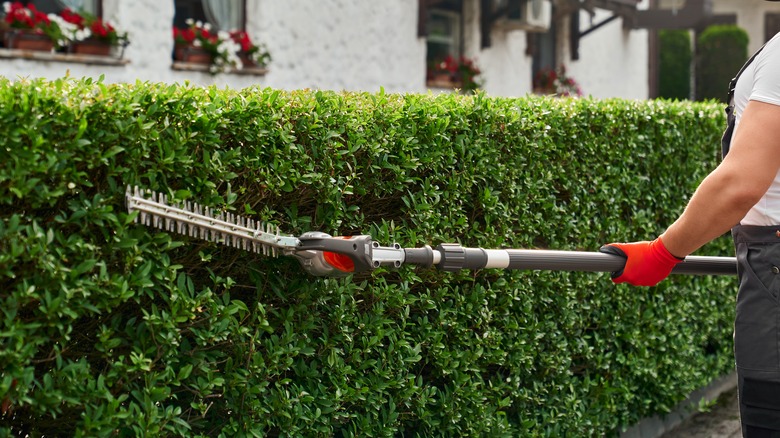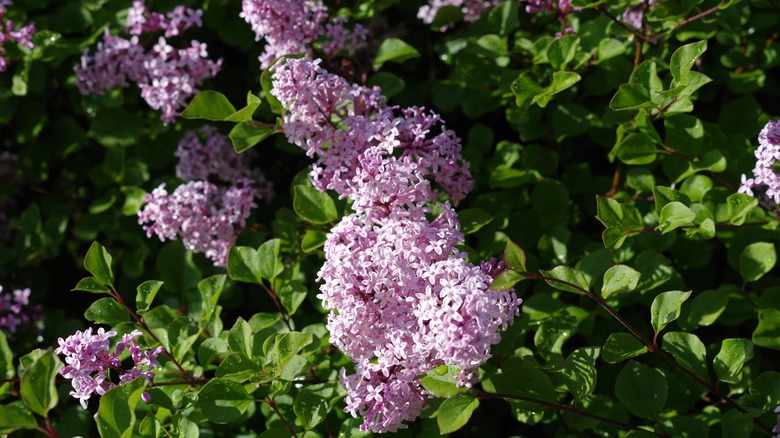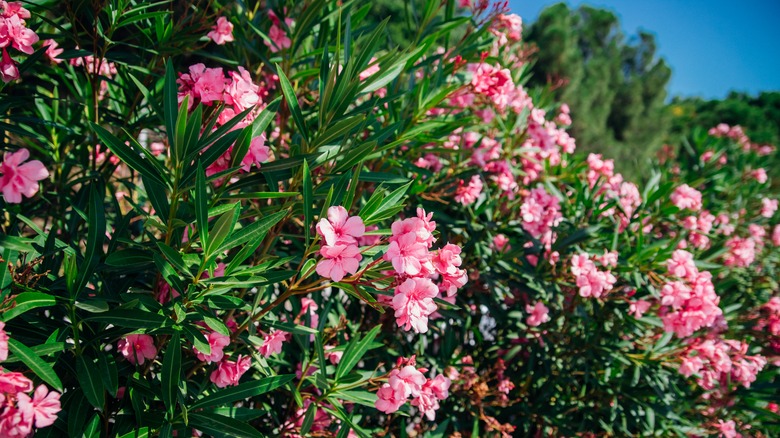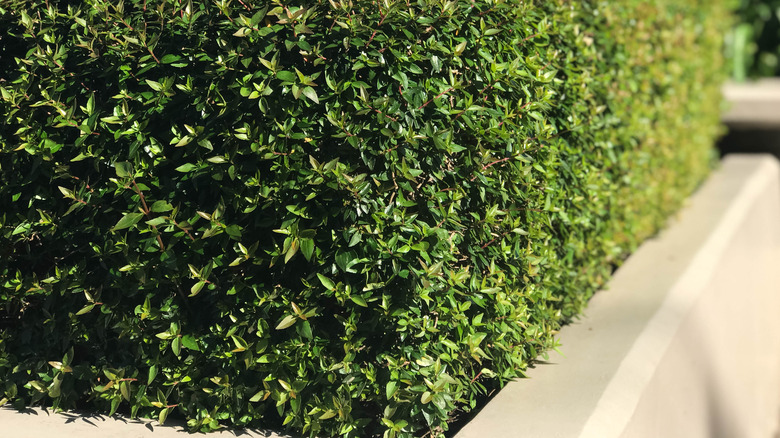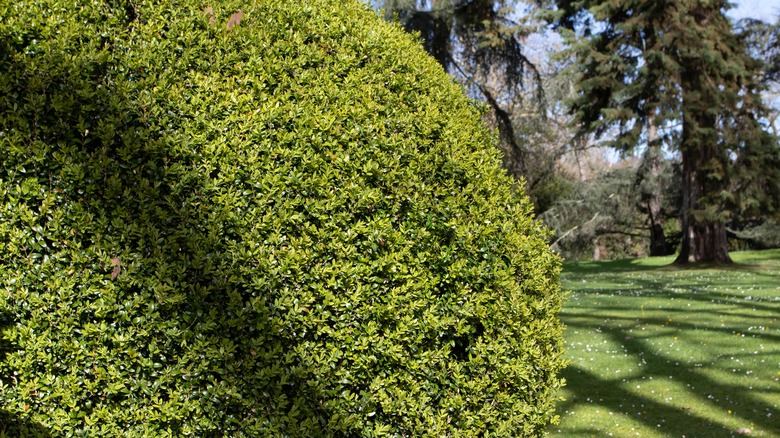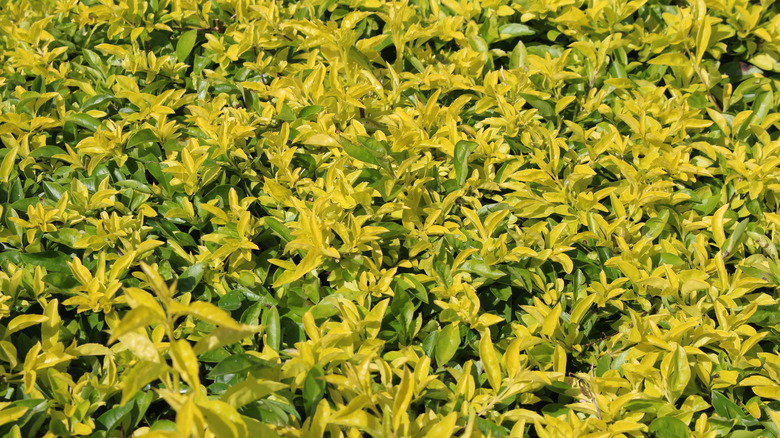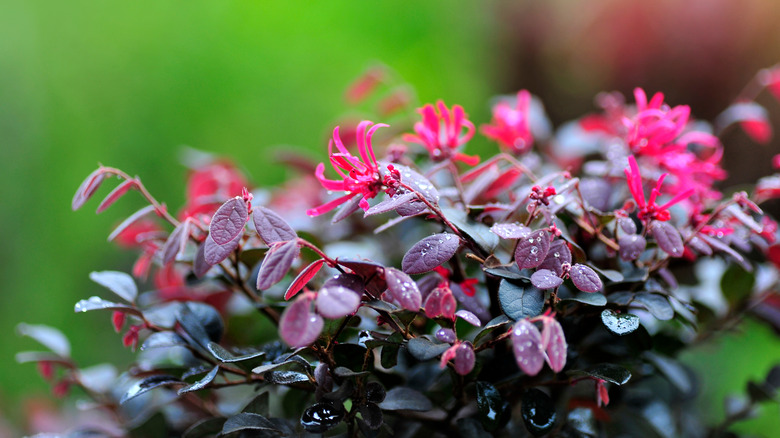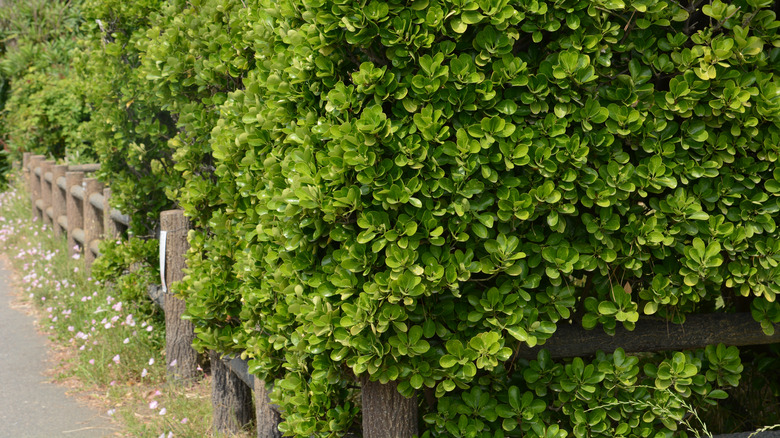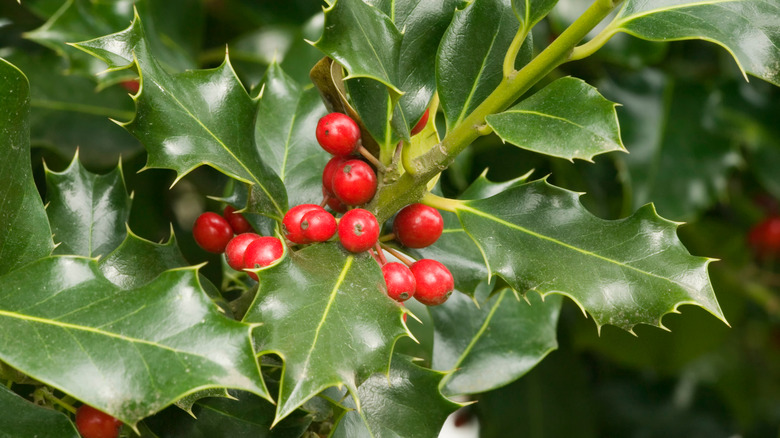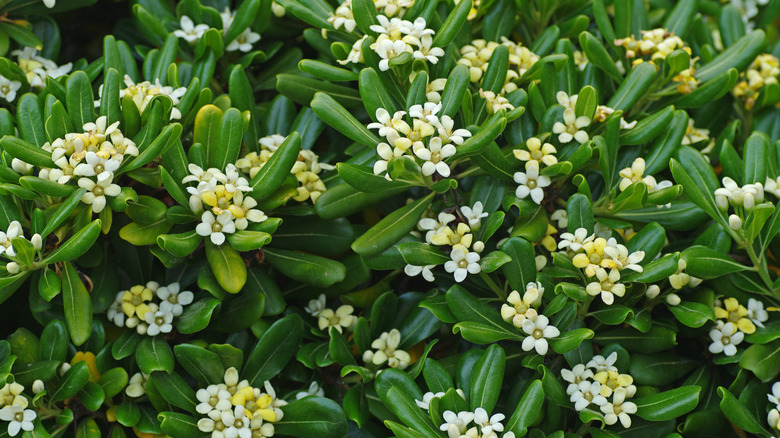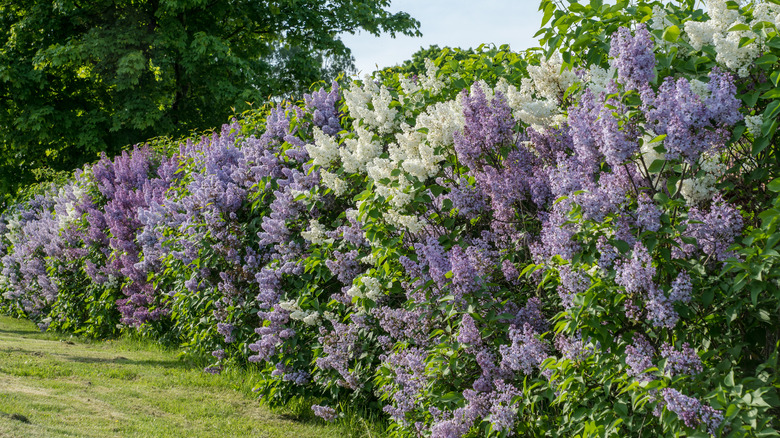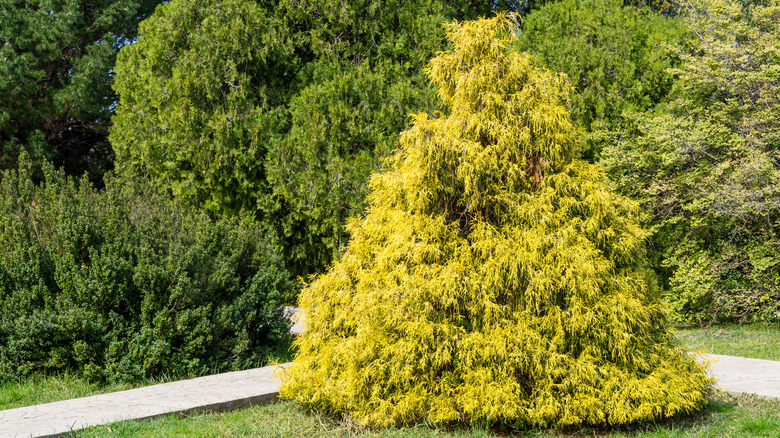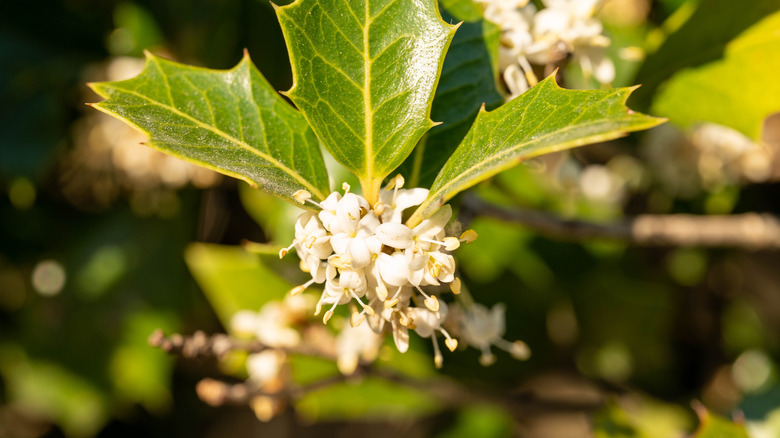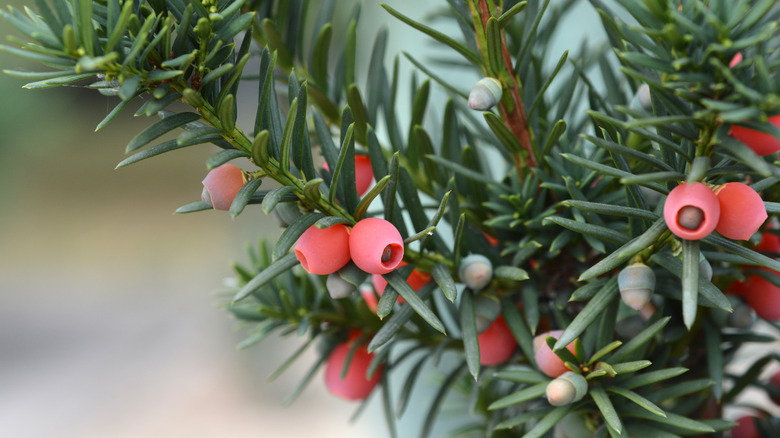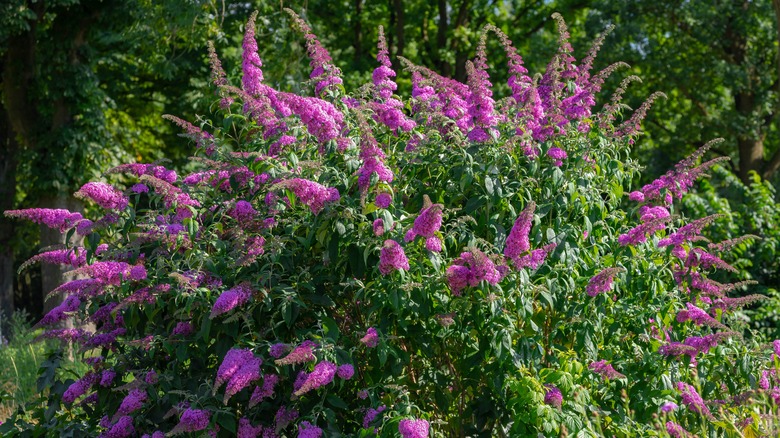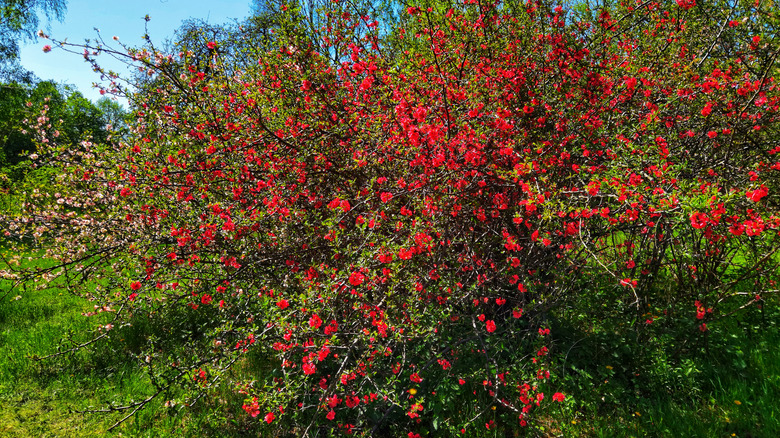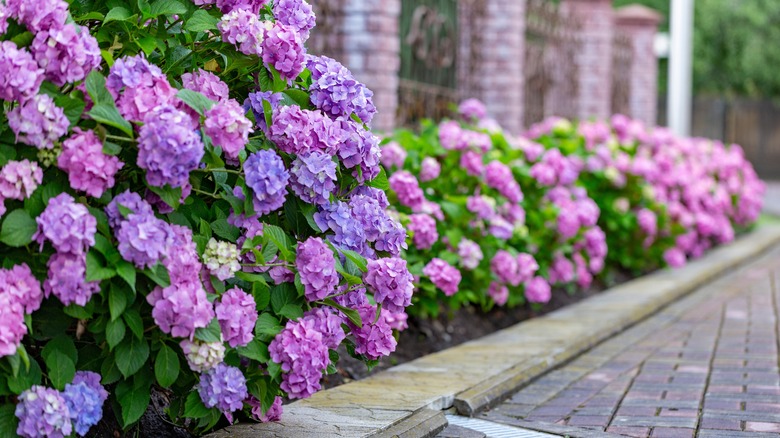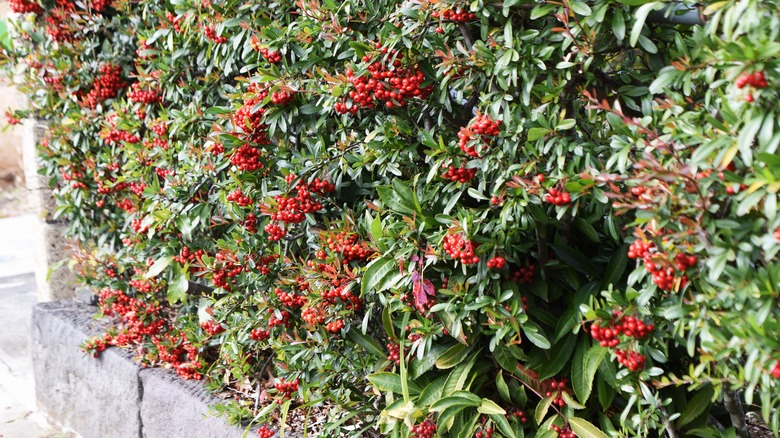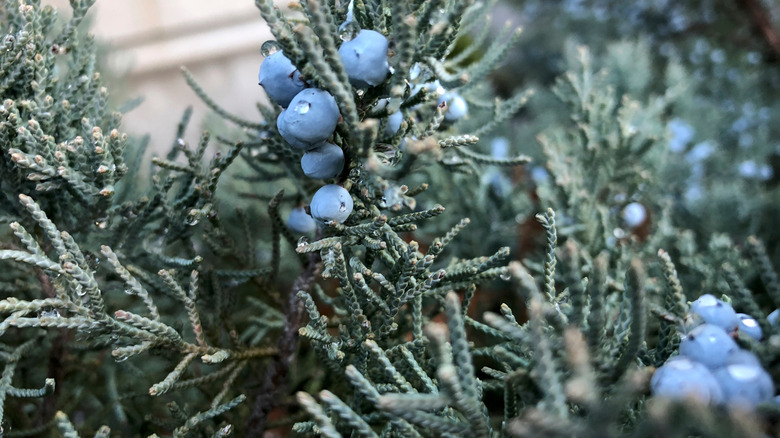18 Best Hedges You Can Plant For Privacy In Your Yard
Looking to make your yard more private? Fences aren't your only option. While some offer a great aesthetic and provide fine concealment, hedges are a natural, low-maintenance, and long-lasting alternative. Many hedges keep their leaves year-round, produce edible fruit, bloom with showy flowers, or grow very tall. Depending on the level of privacy you're looking for, you can choose from shorter shrubs with looser growth habits such as flowering quince. Or, find extremely concealing, dense, and tall options like boxwood and hicks yew.
Often, hedges can save homeowners money in comparison to walls or fences, according to Fixr. As long as you choose shrubs or trees that are well-suited for your climate, you shouldn't have to spend much at all on them after planting. However, you'll want to be prepared for the care needed to show them off. Typically, pruning, supplemental watering, and some fertilization are necessary. Ready to turn your yard into a secluded living oasis? Take a look at these 18 hedging plants.
1. Korean lilac
The Korean lilac (Syringa meyeri) is a deciduous shrub that the Missouri Botanical Garden describes as a fragrant hedge with minimal maintenance requirements. Native to northern China, this plant grows easily in well-draining soil with exposure to direct sunlight. It's also quite cold-hardy, so most U.S. states can support its care requirements easily.
Bloom Season: Spring
USDA Growing Zone: 3 to 7
Growing Conditions: Full sunlight
Soil Type: Well-draining
Size: 5 to 8 feet tall and 6 to 10 feet wide
2. Oleander
Oleander (Nerium oleander) is a well-known evergreen shrub that's commonly seen growing in warm climates. The hedge is widely grown as a screening plant to create more privacy; however, it's also popular because of its beautiful flowers in the spring and summer. Oleander shrubs, per North Carolina State Extension, produce blooms in a range of colors, including cream, yellow, orange, pink, purple, red, white, and more.
Bloom Season: Spring and summer
USDA Growing Zone: 8 to 10
Growing Conditions: Full sunlight and partial shade
Soil Type: Well-draining
Size: 6 to 19 feet tall
3. Glossy abelia
Glossy abelia (Abelia x grandiflora) is best described as a dense semi-evergreen shrub. A cross between Abelia chinensis and Abelia uniflora, this hybrid consistently shows off red to purple foliage year-round, although it's only hardy to USDA growing zone 5. When grown in colder climates, it sheds many of its leaves during the fall and winter seasons, notes the University of Florida.
Bloom Season: Spring to fall
USDA Growing Zone: 5 to 9
Growing Conditions: Partial shade
Soil Type: Acidic and well-draining
Size: 6 to 8 feet tall and wide
4. Boxwood
Boxwood (Buxus spp.) is among the most popular shrubs used for hedging. These densely foliaged plants are frequently pruned into walls, separate spheres, and even fun shapes and characters. Proven Winners notes that the boxwood shrub is often chosen for its easy care requirements and adaptable nature.
Bloom Season: Spring
USDA Growing Zone: 4 to 9
Growing Conditions: Partial shade
Soil Type: Well-drained
Size: 1 to 20 feet tall and 2 to 8 feet wide
5. Vicaryi golden privet
Vicaryi golden privet (Ligustrum x vicaryi) has a bushy, upright shape that can be difficult to maintain. However, if you're looking for a shrub to bring more brightness and a natural feel to your yard, this might be the best option. Monrovia describes this plant as an "ever-changing screen" that quickly reaches more than 8 feet tall.
Bloom Season: Summer
USDA Growing Zone: 5 to 8
Growing Conditions: Full sunlight
Soil Type: Well-draining
Size: 8 to 10 feet tall and wide
6. Chinese fringe flower
The Chinese fringe flower shrub (Loropetalum chinense) is an evergreen shrub with blooms that usually appear in the spring. These blooms, which resemble witch hazel flowers, have thin pink or white petals that look like fringe hanging from the shrub's upright stems, per the Clemson Cooperative Extension. Unless pruned, once the Chinese fringe flower reaches adulthood, it may be as tall as 15 feet.
Bloom Season: Spring
USDA Growing Zone: 7 to 10
Growing Conditions: Full sunlight to partial shade
Soil Type: Moist, acidic, and well-draining
Size: 10 to 15 feet tall and wide
7. Japanese euonymus
Japanese euonymus (Euonymus japonicus), which has some similarities to the boxwood shrub, is known for its many, upright stems covered in small leaves that are leathery to the touch. The foliage of the broadleaf evergreen shrub can be variegated, however, regular direct sunlight exposure can force it to revert back to green, as pointed out by Oregon State University.
Bloom Season: Early summer
USDA Growing Zone: 7 to 10
Growing Conditions: Full sunlight to full shade
Soil Type: Well-draining
Size: 10 to 15 feet tall and wide
8. Holly
Holly (Ilex aquifolium) is well-known for its red berries and dark green, oak-like foliage. In the United States, this tree grows best in the Pacific Northwest. It enjoys some shade and some sun as well as well-draining soil. Additionally, as explained by North Carolina State Extension, holly can tolerate soils that are nutrient-poor or highly acidic.
Bloom Season: Spring
USDA Growing Zone: 5 to 9
Growing Conditions: Full sunlight to partial shade
Soil Type: Well-draining
Size: 30 to 50 feet tall and 15 to 25 feet wide
9. Japanese mock orange
Japanese mock orange (Pittosporum tobira) is an easy-to-grow shrub with an erect growth habit and attractive foliage and flowers. The flowers are normally about an inch wide and cluster together between the plant's glossy leaves. According to Oregon State University, these beautiful blooms smell just like orange blossoms.
Bloom Season: Spring
USDA Growing Zone: 8 to 10
Growing Conditions: Full sunlight to partial shade
Soil Type: Well-draining
Size: 15 feet tall and wide
10. Lilac bush
Lilac bushes (Syringa vulgaris) are one of the best options for planting as screens, hedges, or borders if you live in a colder climate, says The Morton Arboretum. This bush, with a long history of use in gardens, is known for its clusters of light purple to mauve flowers that are wonderfully fragrant. Plant this shrub in well-draining soil with plenty of room around it to spread.
Bloom Season: Spring
USDA Growing Zone: 3 to 7
Growing Conditions: Full sunlight
Soil Type: Acidic and well-draining
Size: 12 to 16 feet tall and 8 to 12 feet wide
11. Sawara false cypress
Sawara false cypress (Chamaecyparis pisifera f. filifera) can be grown in most parts of the United States. It has a slow, but dense growth habit. With time, they become extremely ornamental and quite tall unless pruned, notes the University of Florida. You can identify this shrub by its hanging scale-like foliage that resembles common cypress.
Bloom Season: Flowers are insignificant
USDA Growing Zone: 5 to 8
Growing Conditions: Full sunlight to partial shade
Soil Type: Acidic and well-draining
Size: 25 to 35 feet tall and 20 to 30 feet wide
12. False holly
False holly (Osmanthus heterophyllus), which grows much smaller than common holly, is a broadleaf evergreen shrub native to some Asian countries. Like common holly, this plant has glossy oak-like leaves and small fragrant flowers, according to the Missouri Botanical Garden. To grow properly, this Osmanthus species needs warm temperatures and rich soil. With the right care, it makes for a great hedge or screen.
Bloom Season: Fall
USDA Growing Zone: 7 to 9
Growing Conditions: Full sunlight to partial shade
Soil Type: Rich, moist, and well-draining
Size: 8 to 10 feet tall and wide
13. Hicks yew
Hicks yew (Taxus x media 'Hicksii') is a hybrid shrub that grows rather tall, but not overly wide. When planted in tight rows, the traditional hedge plant creates a thick wall or privacy screen. Monrovia warns gardeners that many parts of this shrub are poisonous to humans and animals and should not be grown near small children, pets, or livestock.
Bloom Season: Insignificant flowers
USDA Growing Zone: 4 to 7
Growing Conditions: Full sunlight to partial shade
Soil Type: Moist and well-draining
Size: 10 to 12 feet tall and 3 to 4 feet wide
14. Butterfly bush
The butterfly bush (Buddleia davidii) is named for its ability to attract butterfly species during its summer bloom season. While the flowers on this tall-growing bush are small and fragrant, they are clustered together for a show of amazing color. Oregon State University suggests purchasing a sterile cultivar of this plant due to it being considered a weed, which has adversely affected many areas where it has naturalized.
Bloom Season: Summer
USDA Growing Zone: 5 to 11
Growing Conditions: Full sunlight
Soil Type: Well-draining
Size: 8 to 12 feet tall
15. Flowering quince
Flowering quince (Chaenomeles japonica) is chosen for its large blooms that appear early on in the growing season. A member of the rose family, these flowers not only are attractive, but they also give way to fragrant and edible fruit, according to the Missouri Botanical Garden. Though the plant only grows to about 3 feet tall, it does spread widely to create a barrier across your yard.
Bloom Season: Late winter
USDA Growing Zone: 5 to 9
Growing Conditions: Partial to full sunlight
Soil Type: Well-draining
Size: 2 to 3 feet tall and 3 to 6 feet wide
16. Hydrangea bush
Hydrangea bushes (Hydrangea macrophylla) are commonly grown as foundation plantings, hedges, and mass plantings, per North Carolina State Extension. This deciduous shrub is attractive to many because of its large clusters of flowers that come in a wide variety of colors. Before planting, remember that hydrangea bushes need shade to survive, so pick out your garden plot first.
Bloom Season: Summer
USDA Growing Zone: 6 to 11
Growing Conditions: Dappled sunlight to full shade
Soil Type: Evenly moist and well-draining
Size: 3 to 6 feet tall and wide
17. Scarlet firethorn
Scarlet firethorn (Pyracantha coccinea), a popular member of the Pyracantha genus, is named for its thorny branches and many bright red berries that grow on the shrub during most of its growing season. Clemson Cooperative Extension recommends planting it as a hedge or as a barrier. However, be careful not to plant it near any structures because it grows tall rather quickly.
Bloom Season: Spring
USDA Growing Zone: 6 to 9
Growing Conditions: Full sunlight to partial shade
Soil Type: Well-draining
Size: 10 to 15 feet tall and 10 feet wide
18. Juniper
Juniper (Juniperus virginiana), also called Eastern red cedar, is a tree that may be used as a tall hedge in your yard. North Carolina State Extension suggests planting them in small groups to create a tall screen for privacy. Keep in mind, the flowers, fruit, and leaves of juniper are poisonous, though the symptoms after consumption are mild.
Bloom Season: Spring
USDA Growing Zone: 2 to 9
Growing Conditions: Full sunlight to partial shade
Soil Type: Well-draining
Size: 30 to 40 feet tall
